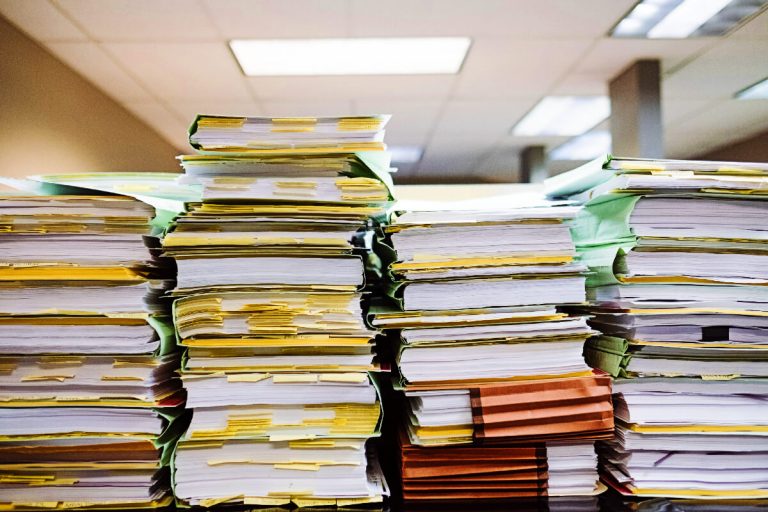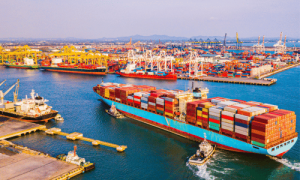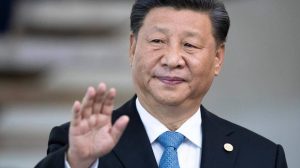Paper-based trade is a drag on the efficiency of the global trading system. Digitization will make trade and supply chains more robust, and the world more secure.
A trade transaction can be accompanied by a small forest worth of paper forms that crisscross between buyers, sellers, ports, customs officials and banks, each one physically delivered and signed before moving on to the next signatory.
In addition to being extremely inefficient, this cumbersome process makes global trade and supply chains dangerously fragile, especially when hit with a crisis. As the pandemic has shown, it is critical to get goods such as food, medical equipment and personal protective gear to where they’re needed as fast as possible. To do that, we need to make global trade and supply chains more robust and secure.
The good news is that trade finance is changing to meet these needs. COVID-19 has helped push efforts toward digitizing trade transactions to a tipping point. The virus caused shortages and manufacturing shutdowns that were felt throughout the global trading system. Without the flexibility in documentation we have seen displayed during the pandemic, vital trade might have been cut off completely.
Had this pandemic occurred even three years ago, the situation would have been much worse. In a short time, the move toward digitization has gained pace and advanced far enough that full-on disaster was avoided.
From here, we need to maintain momentum. The efforts made thus far to digitize trade need to spread throughout the global trading system, with the somewhat scattershot range of approaches being tried narrowed to the point that we have digital tools that everyone can use.
In line with this effort, the ADB trade finance team has worked with the government of Singapore and the International Chamber of Commerce to create those digital standards and protocols for trade by launching the Digital Standards Initiative.
“The world is struggling to transition to digital at scale,” Oswald Kuyler, the initiative’s managing director, said in a recent interview in Global Trade Review. “Today, there are many excellent trade platforms, but they need standards to help them transition from being digital islands to platforms that can engage in a rich ecosystem of platforms.”
Moving the digitization agenda forward is critical for more robust and resilient trade and supply chains. It will also help drive efficiency and productivity gains that will be important component parts to rebuild the global economy.
Digital trade makes sense from the perspective of the system as a whole but it also creates a more efficient system that will make it easier for developing countries to take advantage of global trading.
Trade is about trust. Buyers need assurance that they will get what they paid for. Sellers want to know that they will get paid for what they sell, and regulators need to confirm that no laws are broken in the process.
The documentation that has built up around global trade is essentially a mechanism to provide confirmation of those trust issues. Digitalization can improve on those paper-based confirmations while providing big gains in efficiency at the same time.
In September, a credit guarantee transaction using distributed ledger technology was used to finance a $50,000 shipment from Thailand to Viet Nam. This transaction was confirmed instantaneously online to all the parties. Instead of the usual transaction time of a few days, the financing was completed in minutes. Distributed ledger technology is a good example of how digitization can make a difference.
The transaction was supported by ADB’s Trade and Supply Chain Finance Program and Contour Pte. Ltd., a Singapore-based company. Contour represents a network of banks using distributed ledger technology to replace the conventional, paper-intensive process used for trade deals.
Distributed ledger technology can cut the time, risk, and effort
involved in financing trade.
Distributed ledger technology can cut the time, risk, and effort involved in financing trade. Through distributed ledger technology, a trade transaction can happen in real time and is confirmed simultaneously to each participant, replacing face-to-face exchanges of multiple documents over a number of days.
There are many efforts underway to test various digital tools. Driving inter-operability will be a key component to drive trade digitization.
Pushing inter-operability is the core goal of the Digital Standards Initiative. There are well-established trading platforms addressing the need for digital solutions, but they don’t talk to each other. Global trade needs protocols and standards to break down digital silos between component parts of the trade ecosystem: exports, shippers, ports, customs, warehousing, finance, and importers.
The Digital Standards Initiative is tasked with advocating the reconciliation of a myriad of rules and regulations. Trade is global but many of the rules and regulations that govern it are not. Those local rules often stipulate the use of paper document delivery and need to be updated to reflect current digitization efforts.
Model digitization laws proposed by the United Nations Commission on International Trade Law and the International Chamber of Commerce also need to be adopted globally.
A key pillar for the future of trade finance is global adoption of a legal entity identifier, which ensures everyone agree on a common method to simply identify the players involved.
The Global Legal Entity Identifier Foundation has already created an identification system that is transforming the way people do business, evaluate risk and lend money. Global and harmonized, the system was established in 2014 by the Group of Twenty in the wake of the financial crisis, with oversight provided by the Financial Stability Board.
Most recently, the foundation conducted a successful proof of concept study that added biometric identification to the digital identity process that would lock in unique identification even further.
If we can maintain the momentum that was accelerated by the pandemic, paper-based trade finance can become a fading memory instead of a drag on the efficiency of the global trading system. And when we have succeeded, we will have made global trade and supply chains more robust, and the world more secure.




















